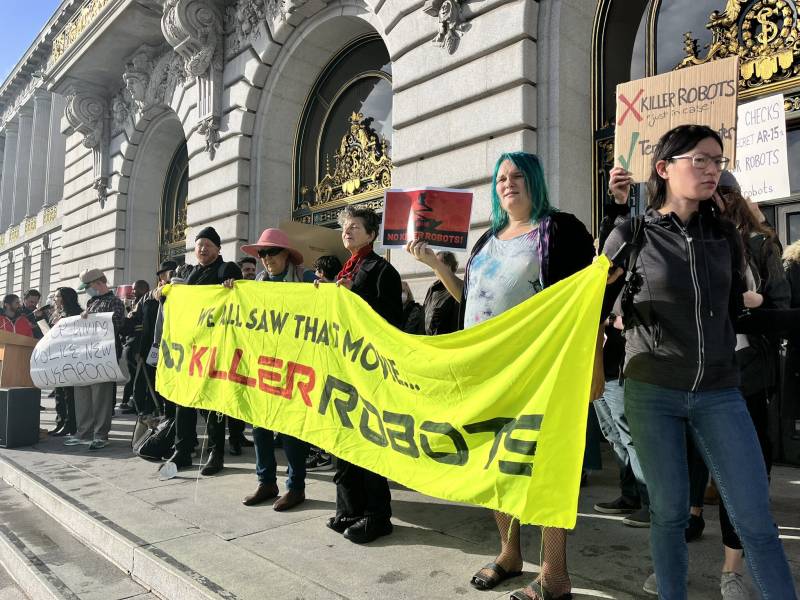“There is no way that I am going to sit by silently and allow a policy as dangerous and as reckless as this to be adopted and to go into effect in the City and County of San Francisco,” Supervisor Dean Preston told protesters on Monday. “We will fight this legislatively at the board, will fight this in the streets and on public opinion and if necessary we will fight this at the ballot.”
In addition to objecting to the use of “killer robots” on the grounds that they could be misused and would make it easier for police to kill people, among other things, opponents Monday said San Francisco police failed to give the required 30-day notice to the public prior to Tuesday’s vote.
“Because there wasn’t any notice that this extremely dangerous policy was going to be trust upon us last minute, we still have hundreds of unanswered questions about the use of killer robots,” Ronen said.
Ronen questioned the ethics of “a machine on the streets of San Francisco being armed and ready to kill human beings,” expressed skepticism about whether the robots were designed for such a purpose and asked about the kind of training, if any, police have had to use them in this way.
“We don’t even have basic information to make this decision,” she said.
While the board’s second, confirming vote on most measures is largely procedural and generally considered a foregone conclusion, Tuesday’s vote is being closely watched, given the mounting backlash against the rule. Already, one supervisor who voted for it last week has since reneged on that decision.
In a Twitter thread on Monday, Supervisor Gordon Mar said he regretted his previous vote for the policy and intends to vote against it tomorrow.
“Even with additional guardrails, I’ve grown increasingly uncomfortable with our vote & the precedent it sets for other cities without as strong a commitment to police accountability. I do not think making state violence more remote, distanced, and less human is a step forward,” Mar said in the tweet.
But even with Mar’s defection, opponents would still need at least two additional supervisors who initially voted in favor of the rule to change their minds in order to reverse last week’s vote.
Supervisor Rafael Mandelman is among the majority on the board who supported the rule and has no intention of changing his mind.
“He continues to believe the policy is reasonable and includes appropriate guardrails,” said Jackie Thornhill, Mandelman’s legislative aide. ” He is not swayed by the opposition and will not be changing his vote.”
So far, police in just two California cities — San Francisco and Oakland — have publicly discussed the use of lethal robots. Oakland recently scrapped consideration of the move after fierce public opposition.
Last week’s vote to approve the use of the robots, which sparked nationwide attention, was prompted by a new California law requiring police to inventory military-grade equipment such as flashbang grenades, assault rifles and armored vehicles, and seek approval from the public for their use.
In an interview with KQED last week, following the vote, Breed defended the policy and dismissed concerns that it would lead to more militarization of local law enforcement.
“[The robots are] not trained to shoot people. There’s a lot of misinformation about what they actually will do,” said Breed.
San Francisco’s vote has renewed a fierce debate sparked years ago over the ethics of using robots to kill a suspect and the doors such policies might open. Largely, experts say, the use of such robots remains rare even as the technology advances.
Michael White, a professor in the School of Criminology and Criminal Justice at Arizona State University, said even if robotics companies present deadlier options at trade shows, it doesn’t mean police departments will buy them. White said companies scrambled to equip body-worn cameras with facial recognition software, but departments didn’t want them.
“Because communities didn’t support that level of surveillance. It’s hard to say what will happen in the future, but I think weaponized robots very well could be the next thing that departments don’t want because communities are saying they don’t want them,” White said.
Robots or otherwise, San Francisco official David Chiu, who authored the California bill when he was in the state Legislature, said communities deserve more transparency from law enforcement and to have a say in the use of militarized equipment.
San Francisco “just happened to be the city that tackled a topic that I certainly didn’t contemplate when the law was going through the process, and that dealt with the subject of so-called killer robots,” said Chiu, who is now San Francisco’s city attorney.
In 2013, police maintained their distance and used a robot to lift a tarp as part of a manhunt for the Boston Marathon bombing suspect, finding him hiding underneath it. Three years later, in 2016, Dallas police officials sent a bomb disposal robot packed with explosives into an alcove of El Centro College to end an hours-long standoff with sniper Micah Xavier Johnson, who had opened fire on officers as a protest against police brutality was ending.

